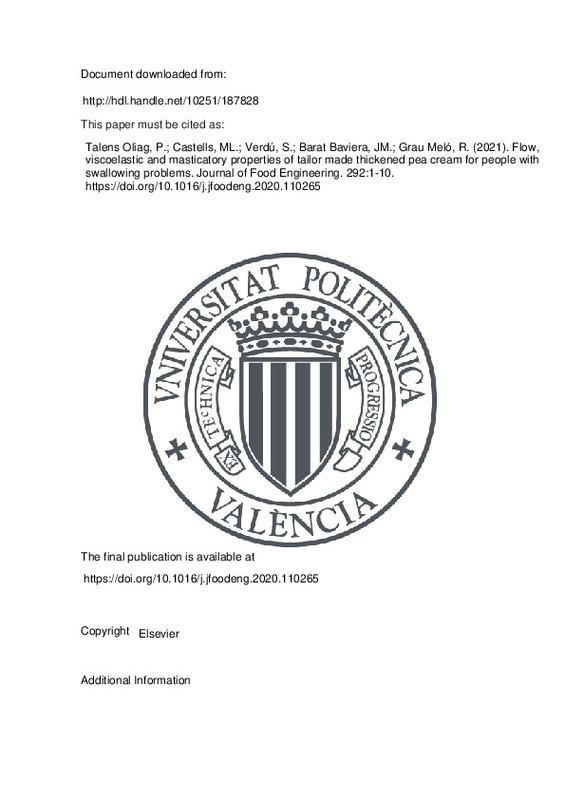JavaScript is disabled for your browser. Some features of this site may not work without it.
Buscar en RiuNet
Listar
Mi cuenta
Estadísticas
Ayuda RiuNet
Admin. UPV
Flow, viscoelastic and masticatory properties of tailor made thickened pea cream for people with swallowing problems
Mostrar el registro sencillo del ítem
Ficheros en el ítem
| dc.contributor.author | Talens Oliag, Pau
|
es_ES |
| dc.contributor.author | Castells, M. L.
|
es_ES |
| dc.contributor.author | Verdú, S.
|
es_ES |
| dc.contributor.author | Barat Baviera, José Manuel
|
es_ES |
| dc.contributor.author | Grau Meló, Raúl
|
es_ES |
| dc.date.accessioned | 2022-10-14T18:02:21Z | |
| dc.date.available | 2022-10-14T18:02:21Z | |
| dc.date.issued | 2021-03 | es_ES |
| dc.identifier.issn | 0260-8774 | es_ES |
| dc.identifier.uri | http://hdl.handle.net/10251/187828 | |
| dc.description.abstract | [EN] This study evaluated the flow, viscoelastic and masticatory properties of tailor made pea cream using different hydrocolloids, and the potential effect that saliva could have while chewing. The creams thickened with pectin, carboxymethyl cellulose, tara gum and konjac gum showed the weakest internal gel structure with highest values of loss tangent at 1Hz (0.49 +/- 0.07), slope of log elastic modulus versus log frequency (0.34 +/- 0.05) and maximum capacitance (0.07 +/- 0.02 Pa-1). The samples thickened with commercial hydrocolloids were affected the most by the presence of saliva, with a significant reduction in apparent viscosity at 10 s(-1), that ranged from 1500 mPas until 11000 mPas. These results demonstrate that it is possible to optimize the structure of thickened pea cream for dysphagia by using, for example, carboxymethyl cellulose, tara gum and konjac gum, because they provide a greater viscous component, and, therefore, a bolus that is more easy to swallow. | es_ES |
| dc.description.sponsorship | The authors thank the "Ministerio Espanol de Ciencia e Innovaci.on" for the financial support provided through the RTI2018-098842-B-I00 Project. | es_ES |
| dc.language | Inglés | es_ES |
| dc.publisher | Elsevier | es_ES |
| dc.relation.ispartof | Journal of Food Engineering | es_ES |
| dc.rights | Reconocimiento - No comercial - Sin obra derivada (by-nc-nd) | es_ES |
| dc.subject | Dysphagia | es_ES |
| dc.subject | Rheology | es_ES |
| dc.subject | Creep recovery | es_ES |
| dc.subject | Oscillatory test | es_ES |
| dc.subject | Thickeners | es_ES |
| dc.subject | Saliva | es_ES |
| dc.subject.classification | TECNOLOGIA DE ALIMENTOS | es_ES |
| dc.title | Flow, viscoelastic and masticatory properties of tailor made thickened pea cream for people with swallowing problems | es_ES |
| dc.type | Artículo | es_ES |
| dc.identifier.doi | 10.1016/j.jfoodeng.2020.110265 | es_ES |
| dc.relation.projectID | info:eu-repo/grantAgreement/AEI/Plan Estatal de Investigación Científica y Técnica y de Innovación 2017-2020/RTI2018-098842-B-I00/ES/AVANCES EN EL DISEÑO DE ALIMENTOS CON TEXTURA MODIFICADA/ | es_ES |
| dc.rights.accessRights | Abierto | es_ES |
| dc.contributor.affiliation | Universitat Politècnica de València. Departamento de Tecnología de Alimentos - Departament de Tecnologia d'Aliments | es_ES |
| dc.description.bibliographicCitation | Talens Oliag, P.; Castells, ML.; Verdú, S.; Barat Baviera, JM.; Grau Meló, R. (2021). Flow, viscoelastic and masticatory properties of tailor made thickened pea cream for people with swallowing problems. Journal of Food Engineering. 292:1-10. https://doi.org/10.1016/j.jfoodeng.2020.110265 | es_ES |
| dc.description.accrualMethod | S | es_ES |
| dc.relation.publisherversion | https://doi.org/10.1016/j.jfoodeng.2020.110265 | es_ES |
| dc.description.upvformatpinicio | 1 | es_ES |
| dc.description.upvformatpfin | 10 | es_ES |
| dc.type.version | info:eu-repo/semantics/publishedVersion | es_ES |
| dc.description.volume | 292 | es_ES |
| dc.relation.pasarela | S\428634 | es_ES |
| dc.contributor.funder | AGENCIA ESTATAL DE INVESTIGACION | es_ES |







![[Cerrado]](/themes/UPV/images/candado.png)

